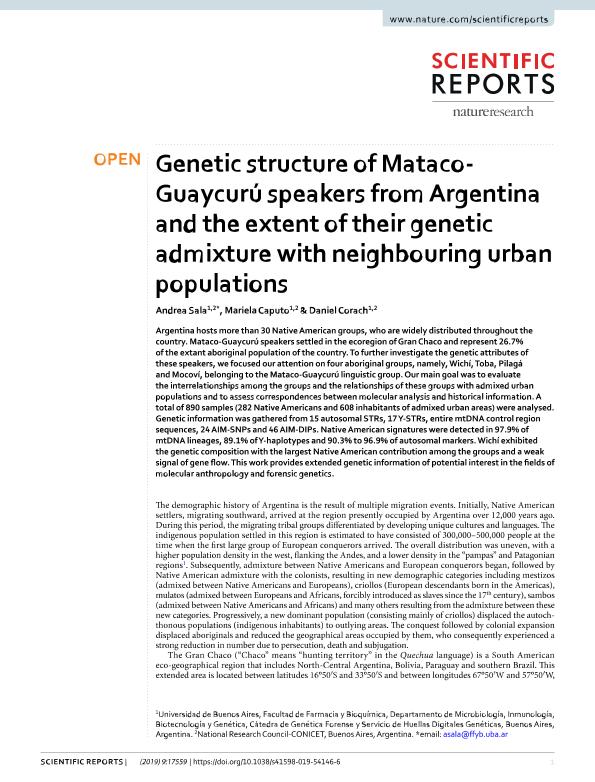Artículo
Genetic structure of Mataco-Guaycurú speakers from Argentina and the extent of their genetic admixture with neighbouring urban populations
Fecha de publicación:
11/2019
Editorial:
Nature Publishing Group
Revista:
Scientific Reports
ISSN:
2045-2322
Idioma:
Inglés
Tipo de recurso:
Artículo publicado
Clasificación temática:
Resumen
Argentina hosts more than 30 Native American groups, who are widely distributed throughout the country. Mataco-Guaycurú speakers settled in the ecoregion of Gran Chaco and represent 26.7% of the extant aboriginal population of the country. To further investigate the genetic attributes of these speakers, we focused our attention on four aboriginal groups, namely, Wichí, Toba, Pilagá and Mocoví, belonging to the Mataco-Guaycurú linguistic group. Our main goal was to evaluate the interrelationships among the groups and the relationships of these groups with admixed urban populations and to assess correspondences between molecular analysis and historical information. A total of 890 samples (282 Native Americans and 608 inhabitants of admixed urban areas) were analysed. Genetic information was gathered from 15 autosomal STRs, 17 Y-STRs, entire mtDNA control region sequences, 24 AIM-SNPs and 46 AIM-DIPs. Native American signatures were detected in 97.9% of mtDNA lineages, 89.1% of Y-haplotypes and 90.3% to 96.9% of autosomal markers. Wichí exhibited the genetic composition with the largest Native American contribution among the groups and a weak signal of gene flow. This work provides extended genetic information of potential interest in the fields of molecular anthropology and forensic genetics.
Palabras clave:
population genetic
,
native american
,
DNA markers
Archivos asociados
Licencia
Identificadores
Colecciones
Articulos(OCA HOUSSAY)
Articulos de OFICINA DE COORDINACION ADMINISTRATIVA HOUSSAY
Articulos de OFICINA DE COORDINACION ADMINISTRATIVA HOUSSAY
Citación
Sala, Adriana Andrea; Caputo, Mariela; Corach, Daniel; Genetic structure of Mataco-Guaycurú speakers from Argentina and the extent of their genetic admixture with neighbouring urban populations; Nature Publishing Group; Scientific Reports; 9; 1; 11-2019; 17559-17572
Compartir
Altmétricas




